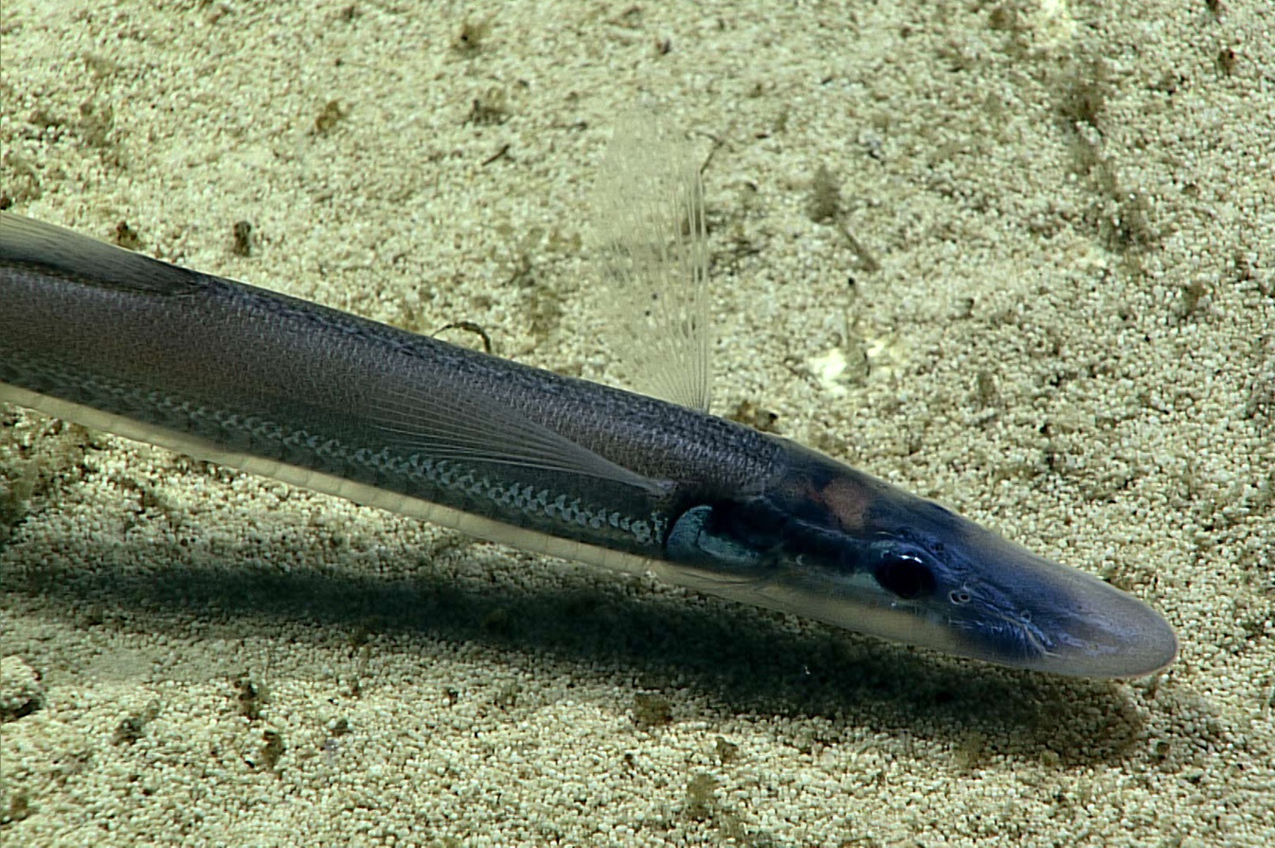Baldhead Halosaur, Aldrovandia phalacra (Vaillant 1888)
Other Names: Halosaur, Hawaiian Halosaurid Fish

Baldhead Halosaur, Aldrovandia phalacra. Source: NOAA Okeanos Explorer / NOAA Office of Ocean Exploration and Research. License: CC by Attribution-NonCommercial-ShareAlike
Summary:
A pale gray halosaur with a silvery-blue head, becoming darker below and on the gill cover.
Cite this page as:
Bray, D.J. 2020, Aldrovandia phalacra in Fishes of Australia, accessed 24 Apr 2024, https://fishesofaustralia.net.au/Home/species/2046
Baldhead Halosaur, Aldrovandia phalacra (Vaillant 1888)
More Info
|
Distribution |
Coral Sea off Cape York, Queensland, to east of Woolgoolga, New South Wales, and the Great Australian Bight to the North West Shelf, Western Australia; also the Lord Howe Rise in the Tasman Sea. Elsewhere the species is circumglobal in warm to temperate seas (including the Red Sea). The Baldhead Halosaur is benthopelagic around islands and continental slopes over hard substrates, in depths of 500-2,320 m. |
|
Features |
Late dorsal I, 9-11. Scales absent from dorsal surface of the head; maxillary spine short. The species is sexually dimorphic, and maturing males have enlarged nostrils, with black tubular anterior nostrils. |
|
Feeding |
Feeds on crustaceans such as amphipods, mysids and copepods, and on polychaete worms. |
|
Etymology |
The specific name phalacra is from the Greek phalakros (= bald-headed) in reference to lack of scales on upper portion of the head. |
|
Author |
Bray, D.J. 2020 |
|
Resources |
Baldhead Halosaur, Aldrovandia phalacra (Vaillant 1888)
References
Filatova, N.A. 1985. Halosaurs (Notacanthiformes) of the Indian Ocean. Journal of Ichthyology 25(6): 22-35.
Haedrich, R.L. & Merrett, N.R. 1988. Summary atlas of deep-living demersal fishes in the North Atlantic Basin. Journal of Natural History 22: 1325-1362.
McDowell, S.B. 1973. Order Heteromi (Notacanthiformes), pp. 1-228 in Cohen, D.M. et. al. Fishes of the western North Atlantic. Memoir. Sears Foundation of Marine Research 1(6): : i-xii + 1-698.
Pakhorukov, N.P. 1999. Observations of deep-sea fishes from submersibles in the Sierra Leone Rise area (Atlantic Ocean). Journal of Ichthyology 39(8): 626-633.
Shelyagin, D.I. 2010. Osteology of Halosauridae (Notacanthiformes). Journal of Ichthyology 50(7): 512-528. https://doi.org/10.1134/S0032945210070039
Smith, D.G. 1999. Families Halosauridae, Notacanthidae, Lipogenyidae, Anguillidae, Moringuidae, Chlopsidae, Myrocongridae. pp. 1625-1642 in Carpenter, K.E. & Niem, V.H. (eds). The Living Marine Resources of the Western Central Pacific. FAO Species Identification Guide for Fisheries Purposes. Rome : FAO Vol. 3 pp. 1397-2068.
Sulak, K.J. 1986. Family No. 52: Notacanthidae (pp. 195-196), in Smith, M.M. & Heemstra, P.C. (eds). Smith's Sea Fishes. Johannesburg : Macmillan South Africa xx + 1047 pp. 144 pls.
Sulak, K.J. 1986. Halosauridae, pp. 593-598. In: Whitehead, P.J.P., Bauchot, M.-L., Hureau, J.-C. & Tortonese, E. (eds) 1986. Fishes of the North-eastern Atlantic and the Mediterranean. Paris : UNESCO Vol. 2 pp. 517-1007.
Tighe, K. 2015. Aldrovandia phalacra.The IUCN Red List of Threatened Species 2015: e.T195838A2425617. http://dx.doi.org/10.2305/IUCN.UK.2015-4.RLTS.T195838A2425617.en. Downloaded on 15 July 2017.
Trunov, I.A. 1999. New data on species of fish from subantarctic and Antarctic waters of the Atlantic Ocean. Journal of Ichthyology 39(7): 488-497.
Vaillant, L.L. 1888. Expéditions Scientifiques du Travailleur et du Talisman pendant les années 1880, 1881, 1882, 1883. Paris: G. Masson 406 pp. 28 pls. See ref at BHL





